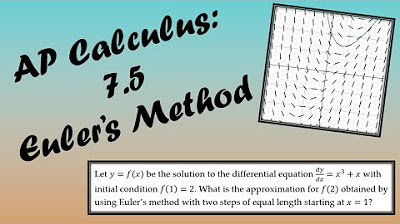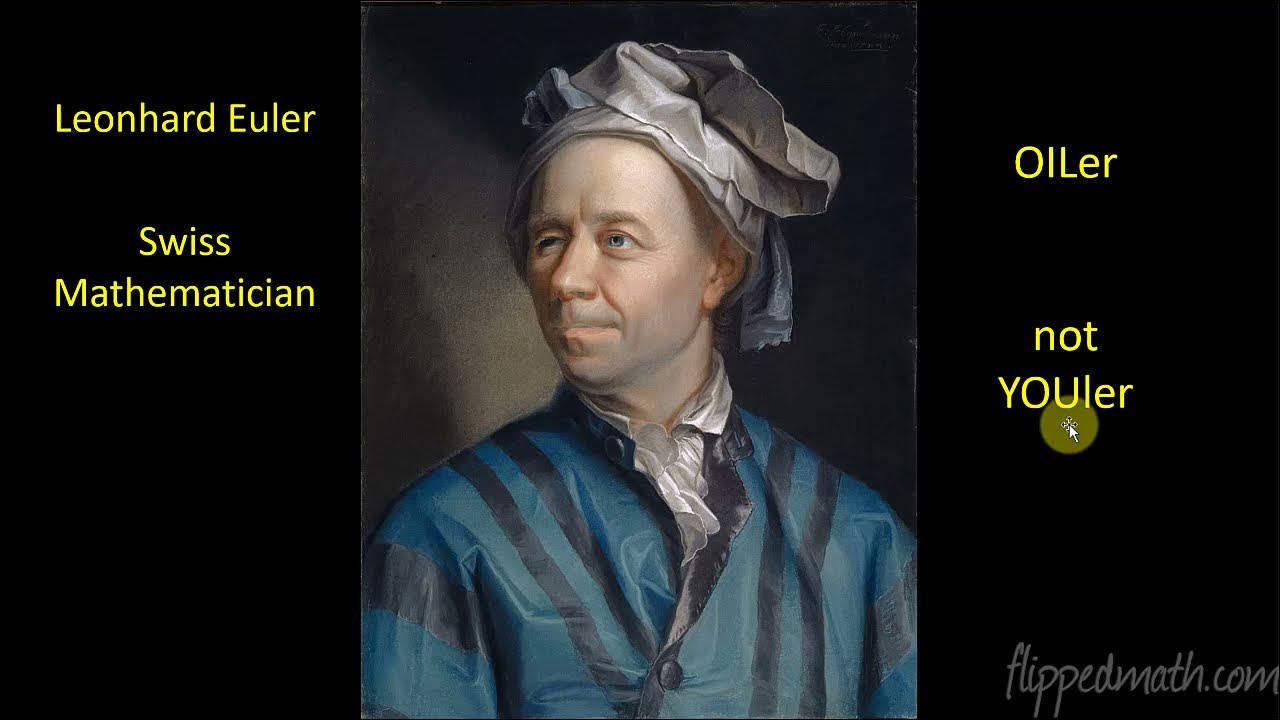Improved Euler Method
TLDRThe provided transcript details the process of using the improved Euler method, an advancement over the basic Euler method for approximating values of functions, particularly those related to differential equations. The speaker explains the concept by first introducing the basic Euler method, which uses the derivative at an initial point to approximate the next point on a curve. The improved method, however, takes into account the derivative at both the initial and subsequent points, averaging the two to create a more accurate approximation. The process is demonstrated with a specific problem involving the derivative function y' = x*y, starting from the initial condition (1,1) and using a step size (h) of 0.1 to approximate the value of y when x equals 1.3. The speaker also compares the results of the improved Euler method to the basic Euler method and emphasizes the increased accuracy of the improved method. The summary concludes by noting that while these methods are useful, higher order methods like Runge-Kutta are generally preferred for greater accuracy, especially when implemented in computer algorithms where smaller step sizes can be used for more precise calculations.
Takeaways
- 📐 **Euler's Method**: A numerical technique to approximate values of a function given its derivative, using a formula `y_(n+1) = y_n + h * f(x_n, y_n)` where `h` is a small increment.
- 🔍 **Improved Euler's Method**: Enhances accuracy by considering the slope of the tangent line at both the initial and a nearby point, averaging these to improve the approximation.
- 🔄 **Tangent Line Utilization**: The method uses the tangent line's slope at the initial condition and at a subsequent point `(x1, y1)` to estimate the function's value.
- 📈 **Derivative Behavior**: The quality of the derivative's behavior influences the slope of the tangent line, which is crucial for the approximation process.
- 🔴 **Initial Condition**: The process begins with an initial condition `(x0, y0)` and uses the derivative at this point to establish the first slope.
- 🔵 **Slope Calculation**: The slopes are calculated using the derivative function `f(x, y)` at the initial and subsequent points.
- 💡 **Averaging Slopes**: The improved method takes the average of the two slopes (`slope1` and `slope2`) to achieve a more accurate approximation.
- 📊 **Formula Application**: The improved Euler's method formula is applied iteratively to move from one point to the next, refining the approximation at each step.
- 📉 **Smaller Increments**: Using smaller values for `h` can lead to more accurate approximations, though it may require more iterations.
- 🖥️ **Computer Implementation**: In practice, the method is often implemented in computer programs, allowing for very small increments and high precision.
- ⚙️ **Higher-Order Methods**: For greater accuracy, higher-order methods like Runge-Kutta (RK4) are preferred, especially for complex or precise calculations.
- 📋 **Comparison of Methods**: The script provides a comparison between the basic and improved Euler's methods, demonstrating the improved method's enhanced accuracy.
Q & A
What is the basic concept of Euler's method for approximating values of a function?
-Euler's method is an iterative technique used to approximate the values of a function near an initial condition, given information about the derivative. It uses small horizontal increments, denoted as H, to move from an initial point (x0, y0) to a specific x value where an approximation is sought. The formula y_(n+1) = y_n + h * f(x_n, y_n) is used, which is based on the slope of the tangent line at the initial condition.
How does the Improved Euler method differ from the basic Euler method?
-The Improved Euler method, also known as Heun's method, enhances the basic Euler method by incorporating an additional piece of information to improve the accuracy of the approximation. It uses the average of the slopes from the tangent line at the initial condition and the slope at the next point (x1, y1) to make a more accurate prediction of the y value.
What is the formula used in the Improved Euler method to approximate the next y value?
-The formula used in the Improved Euler method is y1 = y0 + (h/2) * [f(x0, y0) + f(x0 + h, y0 + h * f(x0, y0))], where f(x, y) is the derivative function, h is the small horizontal increment, and (x0, y0) is the initial condition.
How does the Improved Euler method calculate the average slope?
-The Improved Euler method calculates the average slope by taking the slope at the initial condition (f(x0, y0)) and the slope at the next point (f(x0 + h, y0 + h * f(x0, y0))) and averaging them. This is done by summing these two slopes and dividing by two.
What is the significance of using a smaller horizontal increment (H) in Euler's method?
-Using a smaller horizontal increment (H) in Euler's method allows for a more precise approximation of the function's value. The smaller the increment, the closer the approximation is to the actual value of the function at the specific x value.
What is the role of the derivative in Euler's method?
-The derivative plays a crucial role in Euler's method as it provides the slope of the tangent line at the initial condition, which is then used to approximate the function's value at a nearby point. The method relies on the local linearity assumption near the initial condition.
How does the Improved Euler method handle the calculation of y1 when given the derivative y' = x*y and initial condition (1,1)?
-The Improved Euler method calculates y1 by first determining the slopes at the initial condition (f(1,1) = 1*1) and at the next point (x0 + h, y0 + h * f(x0, y0)). It then averages these slopes and uses the average to find y1 = y0 + (h/2) * [f(x0, y0) + f(x0 + h, y0 + h * f(x0, y0))], which in this case results in y1 ≈ 1.1105 after plugging in the values and performing the calculations.
What is the primary advantage of using a computer to implement Euler's method?
-The primary advantage of using a computer to implement Euler's method is the ability to use a very small horizontal increment (H), which can be made much smaller than what is practical to calculate by hand. This allows for a highly accurate approximation of the function's value, often to many decimal places.
Why might one choose a higher-order method like Runge-Kutta over the Improved Euler method?
-Higher-order methods like Runge-Kutta are chosen for their increased accuracy over methods like the Improved Euler, especially when a very precise approximation is required. These methods take into account more information about the function's behavior over the interval, leading to a more accurate estimate of the function's value at the next point.
What is the general approach to solving differential equations using numerical methods in real-life situations?
-In real-life situations, solving differential equations using numerical methods typically involves programming the chosen method, such as Euler's or Runge-Kutta, into a computer. The computer can then perform the calculations quickly and to a high degree of precision, often with a very small step size, to obtain an accurate approximation of the solution.
How does the accuracy of the Improved Euler method compare to the basic Euler method?
-The Improved Euler method generally provides a more accurate approximation than the basic Euler method. It stays much more in line with the actual values and is less prone to error accumulation over multiple iterations, making it a better choice when a higher degree of accuracy is desired.
What is the practical application of Euler's method and its improved version in approximating the solution to differential equations?
-Euler's method and its improved version are used in a wide range of fields where an approximate solution to a differential equation is needed. This includes physics for modeling motion, engineering for system dynamics, economics for predicting population growth or financial trends, and biology for modeling population dynamics, among others.
Outlines
🔍 Introduction to the Improved Euler Method
The first paragraph introduces the concept of the Improved Euler Method, which is an enhancement of the basic Euler's method for approximating values of functions. It explains that the method uses the derivative at the initial condition and an additional piece of information to increase accuracy. The formula for the Improved Euler Method is given as y_(n+1) = y_n + h * (f(x_n, y_n) + f(x_n + h, y_n + h * f(x_n, y_n))) / 2, where h is a small increment. The paragraph also illustrates the concept using a tangent line and the average of two slopes.
📐 Deriving the Improved Euler Formula
The second paragraph delves into the derivation of the Improved Euler formula. It discusses averaging the slopes at the initial condition and at a nearby point to achieve a more accurate approximation. The paragraph outlines the process of plugging in values for x0, y0, and h into the derivative formula to find the slopes and then averaging them. It emphasizes the importance of a small h value for better approximation and presents a general formula for the next y value in the approximation process.
🔢 Working Through an Example with Improved Euler
The third paragraph presents a step-by-step example of applying the Improved Euler method. It uses the given derivative y' = x*y, initial condition (1,1), and h value of 0.1 to approximate the y value when x equals 1.3. The paragraph shows the calculation process for finding y1, y2, and y3, emphasizing the iterative nature of the method and how each step builds upon the previous one to refine the approximation.
📉 Comparing Improved Euler to the Original and Higher-Order Methods
The final paragraph compares the accuracy of the Improved Euler method to the original Euler method and higher-order methods like Runge-Kutta. It provides a table showing the values obtained from both methods and notes that the Improved Euler method stays much closer to the actual values. The paragraph also discusses the practicality of these methods, suggesting that for very accurate results, a higher-order method like Runge-Kutta would be preferred. It concludes by mentioning that in real-life situations, these calculations are often performed by computer algorithms, allowing for very small h values and high accuracy.
Mindmap
Keywords
💡Euler's Method
💡Improved Euler's Method
💡Derivative
💡Tangent Line
💡Initial Condition
💡Step Size (H)
💡Slope
💡Approximation
💡Separable Differential Equation
💡Accuracy
💡Runge-Kutta Methods
Highlights
Introduction to Euler's method for approximating values of a function given its derivative.
Explanation of using small horizontal increments (H) to move from an initial condition to approximate a specific x value.
Description of the formula for Euler's method: y_(n+1) = y_n + h * f(x_n, y_n).
Introduction of the improved Euler method for increased accuracy by considering additional information.
Concept of averaging the slopes of the tangent line at the initial condition and at the next x value (X1).
Derivation of the improved Euler's method formula by averaging the slopes from two points.
Application of the improved Euler's method to find the Y value at X = 1.3 using the given derivative y' = x * y.
Use of initial condition (1,1) and step size H = 0.1 in the improved Euler's method.
Calculation of Y1, Y2, and Y3 to approximate the Y value at X = 1.3.
Comparison of the improved Euler's method with the basic Euler's method in terms of accuracy.
Discussion on the practical use of Euler's method and when higher-order methods like Runge-Kutta might be more appropriate.
Mention of the potential for computers to use very small step sizes for high accuracy in numerical methods.
Emphasis on the importance of choosing an appropriate method based on the desired level of accuracy.
Highlight of the improved Euler's method as a practical tool for hand calculations and its comparison with computer-assisted calculations.
Advice on programming numerical methods into computers for efficient and accurate calculations.
Encouragement for viewers to practice hand approximation and to understand the underlying concepts of numerical methods.
Transcripts
Browse More Related Video
5.0 / 5 (0 votes)
Thanks for rating:





